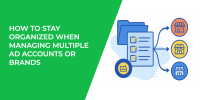Opening a new physical store is exciting, but getting people through the door is often harder than it seems. Flyers and word-of-mouth help, yet they rarely reach enough of the right people. That’s where Facebook Ads shine: they give local businesses a way to build buzz, attract the right audience, and turn online attention into real-world foot traffic.
If you’re preparing for a brick-and-mortar launch, Facebook Ads can be one of the smartest investments you make. Let’s break down how.
Why Facebook Ads Work for Store Openings
Facebook has two things local advertisers need most: scale and precision. You can reach thousands of people in your city, while also narrowing down to specific groups who are more likely to show up. That means your budget isn’t wasted on people who live hours away or have no interest in your product.
Think about it: wouldn’t you rather spend $500 reaching nearby customers who care, instead of shouting into the digital void?
Set a Clear Objective Before Spending a Dollar
The first step is deciding what success looks like. For a store launch, your goal could be:
-
Increasing awareness that your shop is opening soon.
-
Getting customers to RSVP for an opening event.
-
Driving in-store purchases within the first week.
Facebook Ads Manager lets you choose campaign objectives like Awareness, Traffic, or Sales. The right choice depends on how you want people to act before and during your launch.
When setting up campaigns for your launch, it helps to understand how Meta’s objectives work — this guide to choosing the right campaign objective breaks it down clearly.
Location Targeting: Your Best Friend
This is where Facebook Ads become truly powerful for brick-and-mortar businesses.
With location targeting, you can narrow your audience by:
-
City, zip code, or radius around your store address.
-
People living in that area versus travelers who are just passing through.
-
Custom combinations, like “within 10 miles of downtown but not across the river.”
Imagine opening a coffee shop near a university. You could target students within two miles who are interested in cafes, late-night study spots, or live music. Suddenly your ads don’t just reach people — they reach your people.
Local reach is critical, and if you want a broader playbook, check out this step-by-step Facebook marketing strategy for local businesses.
Build Buzz With Teaser Campaigns
Don’t wait until opening day to advertise. Start weeks before with teaser ads.
These can be as simple as:
-
A short video tour of your storefront coming together.
-
A carousel ad showing product previews.
-
A countdown graphic highlighting “7 days to go.”
The goal here is anticipation. You want potential customers to be curious enough that they’re already planning a visit before your doors open.
Use Event Ads for the Grand Opening
Your grand opening isn’t just about opening doors — it’s about creating buzz. Facebook Event Ads work because people can RSVP with one click, and their friends often see it too. That ripple effect spreads awareness faster than traditional promos.
Tips for stronger Event Ads:
-
Use clear, time-sensitive headlines (“Grand Opening – This Saturday at 10 AM”).
-
Add eye-catching visuals of your space or products.
-
Highlight a reason to come — giveaways, discounts, or entertainment.
-
Run countdown ads in the final week to build anticipation.
The more excitement you generate beforehand, the bigger your launch crowd will be.
Retarget Warm Audiences
Not everyone will act on the first ad they see. That’s why retargeting is crucial. You can retarget people who:
-
Watched part of your teaser video.
-
Clicked on your website’s “Opening Soon” landing page.
-
Engaged with your event but didn’t RSVP.
These ads don’t need to be fancy. A simple reminder like “Doors open this Saturday at 10 AM” can be the nudge someone needs to visit.
Don’t forget to re-engage the people who showed interest — this retargeting setup guide will walk you through it step by step.
Showcase Social Proof
New stores can feel like a risk. Social proof removes that hesitation by showing others have already trusted you. Encourage customers to share their experiences, then bring that content into your ads.
Ways to build and use social proof:
-
Ask early visitors to tag your store or check in on Facebook.
-
Offer small perks (like 10% off) for leaving reviews or posting photos.
-
Feature customer testimonials or photos in your ads.
-
Highlight numbers: “Over 200 locals visited in our first week.”
-
Partner with local micro-influencers for quick visibility.
When people see others enjoying your store, they’ll be far more likely to stop by themselves.
o make the most of reviews and testimonials in your campaigns, see this guide on using social proof in Facebook Ads.
Track Results Beyond Online Clicks
The tricky part of store launches is measuring offline results. How do you know if someone walked in because of an ad?
Here are a few methods:
-
Offer an exclusive in-store discount code promoted only in ads.
-
Use “Mention this ad” offers to measure redemptions.
-
Compare sales spikes with your campaign dates.
Even imperfect tracking gives you insights to refine your ads for future promotions.
Final Thoughts
A brick-and-mortar launch is a big milestone. But relying on foot traffic alone is risky in today’s world. Facebook Ads allow you to control awareness, drive excitement, and give your new store the attention it deserves.
Start small, test creatives, retarget those who show interest, and measure how your ads translate into real-world visits. Done well, Facebook Ads won’t just fill your grand opening — they’ll set the stage for long-term customer loyalty.

